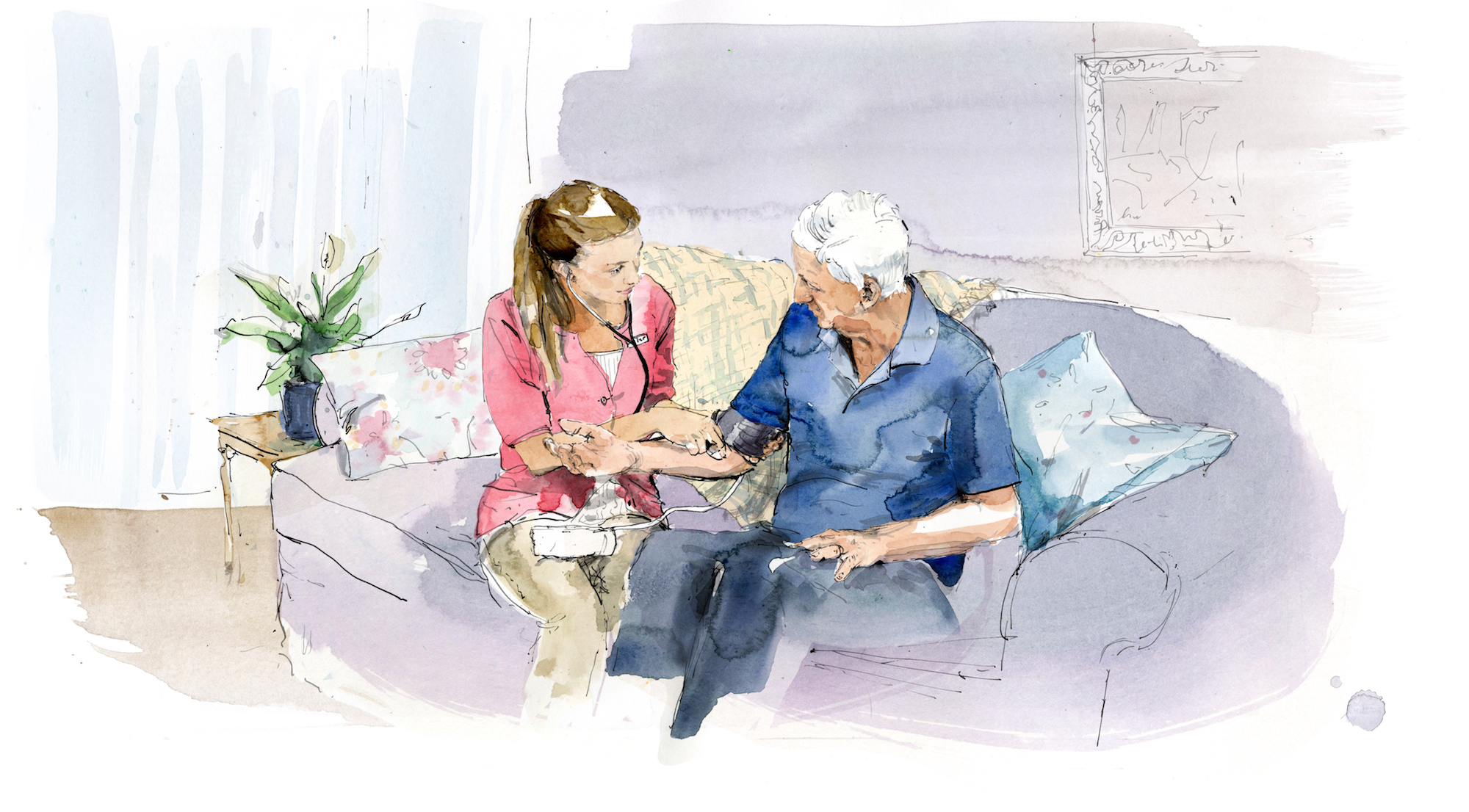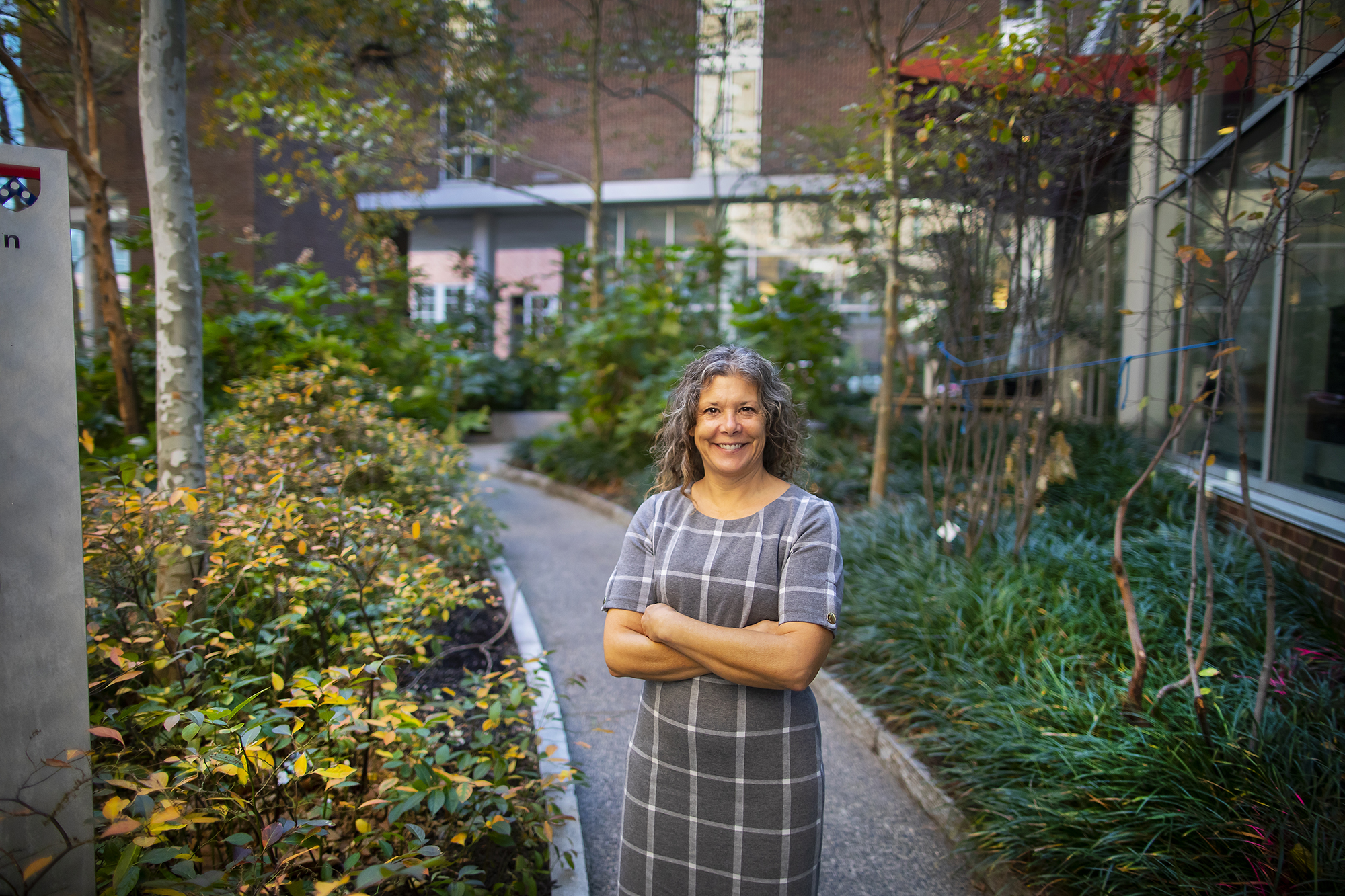
The Veterans Administration has traditionally been an incubator for innovations that improve quality of life not only for veterans but also for civilian populations around the world—ideas like bar-coding machines, or the discovery that daily aspirin cuts the rate of heart attacks for certain patient populations. For many years and in a range of capacities, Penn’s School of Nursing has been a close VA collaborator.
In 2011, for example, in addition to her role at Penn, palliative care professor Mary Ersek became director of the Veteran Experience Center, a national quality-improvement initiative housed at Philadelphia’s Corporal Michael J. Crescenz VA Medical Center. Rosemary Polomano, Penn Nursing’s associate dean for practice and a professor of pain practice, helped change the standard pain scale employed by the VA.
There are many examples of this partnership, with innovative solutions aimed at the largest integrated health system in the U.S. and the top employer of nurse practitioners, according to the Veterans Health Administration. Along the way, the VA has also built systems for tracking outcomes, leading to a treasure trove of data.
“It’s a great time for evidence-based research and training,” says Coy Smith, associate director of patient care services and nurse executive at the Philadelphia VA, as well as assistant dean for clinical practice at Penn Nursing. “A lot of this work is transferrable” to non-VA patients.
Here, a look at the work made possible because of the Veterans Health Administration-Penn Nursing collaboration.
Using evidence to inform practice
Evidence-based health care practices are interventions based on the best, latest scientific findings. Penn sleep and health behavior researcher Amy Sawyer is currently leading 15 evidence-based quality improvement projects at the Philadelphia VA, on subjects like preventing injury in surgical patients and secondary traumatic stress in health care providers.
“Change, no matter how you look at it, is hard,” Sawyer says. “It’s hard to accept, and it’s hard to convey to others that change needs to happen.” But implementing it can have real results, like with a recent occupational health project that involved switching the type of tuberculosis testing the VA used for incoming employees.
Unlike the standard test, called purified protein derivative or PPD, a newer test called T-SPOT.TB does not require a follow-up visit after 48 to 72 hours. During a PPD shortage two years ago, VA clinicians put in place the T-SPOT.TB procedure and followed it for a year. The program has since rolled out across the entire VA system, leading to a 29% increase in employee compliance, a 40% drop in costs, and a 50% reduction in time to clear new hires.
“We used to think of quality improvement and research as separate,” Ersek says. “But over the years we’ve gotten more sophisticated. We use research methods. We sort of mimic, statistically, a randomized control trial.”
To that end, Ersek and her team use the Bereaved Family Survey (BFS) in their VA work. The BFS, developed through a VA-funded research project and now used throughout the system, asks respondents to evaluate quality of care at the end of life. It’s mailed to the next of kin of every veteran who dies at a VA facility or in one of several VA home-based primary care programs. Facility-level scores are calculated quarterly and sent to each facility. The Veteran Experience Center also works directly with care teams to help them interpret their scores and develop strategies to improve care and outcomes.
“For example, we might identify chronically low scores on an overall item, as well as those related to communication for a specific facility,” Ersek says. Training in family conferences might then follow. “We continue to monitor their BFS scores during and following the training to see whether it had an impact on outcomes,” she adds.
The survey is “a unique way to keep a pulse on the quality of care at the VA for veterans and families,” says Ann Kutney-Lee, an adjunct associate professor of nursing who studies the effects of nursing care organizations on patient outcomes. “We ask about communication with providers, whether their preferences were met for treatment,” she says. “We ask about emotional and spiritual support. Did they get the amount of support they wanted? Did they see a chaplain if they wanted one?”
Improving end-of-life care
Veteran demographics are shifting from those who served in World War II and the Korean War to those who served in Vietnam. This has implications for end-of-life care, as veterans from the Vietnam era are more likely to have been exposed to dangerous combat situations, says Kutney-Lee. “Many veterans were fighting in jungles and mountains; there were hidden explosives planted, all with a near-constant threat of being ambushed,” she says. “The nature of the direct combat situations was very different.”
The way society welcomed them home was different, too. World War II vets were hailed as heroes, enjoying national support. Vietnam vets experienced the opposite, says Kutney-Lee. “Things were thrown at them when they got off the planes. Today, “they are less willing to talk about their experiences,” something that can resurface, emotionally, at the end of life.
It’s something Kutney-Lee and colleagues are trying to understand to better prepare health care providers to treat these vets. They are seeing higher rates of anxiety and post-traumatic stress, as well as more chronic illnesses that correlate with chemicals such as 2,4,5-T, an ingredient in the herbicide Agent Orange, to which many soldiers in Vietnam were exposed. In an effort to be proactive, the VA’s Hospice and Palliative Care Program Office and the Veteran Experience Center are using the BFS and other data to create educational programs aimed at helping providers meet this group’s unique end-of-life needs. “We want the vets’ and their families’ experience to be as peaceful as possible,” Kutney-Lee says.
She is involved in another project with Ersek and Margo Brooks Carthon, another Penn Nursing researcher, to study racial and ethnic disparities in quality end-of-life care for vets. Some of their work has found that the next of kin of African American vets were 50% less likely than other groups to report that their loved ones received excellent care at the end of life. The researchers want to know why.
One clue: Members of racial and ethnic minorities tend to be more sensitive to changes in nurse-staffing levels. The researchers hypothesize that in facilities where staffing is better, nurses are better positioned to meet the complex care needs of patients, which may also apply at the end of life. “They have the resources they need and the time to spend with their patients,” says Kutney-Lee.
Standardizing pain management
Pain management entails a complex matrix of mind and body, which makes having a standard scale on which to measure pain crucial.
Penn Nursing’s Rosemary Polomano specializes in managing acute pain following combat-related injuries. After learning that clinicians in 28 facilities who used the standard numeric pain rating scale (0-10) found it inadequate to help patients and health care providers communicate about pain-intensity levels, Polomano collaborated with leaders from the Defense and Veterans Center for Integrative Pain Management and others to develop the Defense and Veterans Pain Rating Scale (DVPRS).
The scale integrates word anchors (from “no pain” to “as bad as it could be, nothing else matters”) with color-coding and facial expressions to help patients rate their pain.
According to Polomano, DVPRS is now the official military pain scale, with the goal of being used in all Department of Defense health care facilities. Other health systems are free to use it too, Polomano says. “It is in the public domain.”
Polomano also teaches Pain Science and Practice, a class open to students from Penn Nursing, Penn Dental, and Penn’s Perelman School of Medicine. This year, in partnership with the Uniformed Services University Graduate School of Nursing in Bethesda, Maryland, 30 active-duty military personnel from their nurse anesthesia program attended the class.
Looking to the future
Nurses work at the heart of the changes in veterans’ care and, therefore, help to shape the future of American health care. “Much of the VA’s innovative models of care delivery are due to the leadership and contributions of VA nurses,” says David Shulkin, a Distinguished Health Policy Fellow at Penn’s Leonard Davis Institute of Health Economics and a former secretary of veterans affairs. “It’s often their affiliation with leading academic centers like Penn that help to ensure the VA remains at the forefront of these innovations.”
“I’ve often felt that the VA is the best place for advanced practice nurses,” says Patricia D’Antonio, the Carol E. Ware Professor in Mental Health Nursing and director of the Barbara Bates Center for the Study of the History of Nursing. One of the best jobs she says she ever had was working with VA nurses to identify and help patients with compelling emotional or psychological needs. One patient, an outgoing, lovable former boxer, would sometimes lash out and punch someone when he got upset. The VA nurses developed a plan to appoint him an unofficial nursing assistant. “He followed a nurse around, carried water, etc. He had a job to do,” says D’Antonio. With a new sense of purpose, he could control his anger. No more punching.
Ersek was similarly drawn to the VA’s work. “Being involved in the military, that’s a big honor. Our mission as care providers is not about prestige,” she says. “We get to use rigorous research methods, but I like that we stop and say it’s not just an academic exercise; it’s about using these advanced analytic methods to improve care for veterans.”
That sense of purpose goes a long way. “I haven’t practiced clinically at the VA since 1992,” says D’Antonio, “but I still describe myself as a VA nurse. It’s part of my identity.” That’s true for many among the ranks of Penn Nursing faculty, who work hand in hand with the nation’s largest integrated care system treating a unique patient population that’s changing every day.
A longer version of this feature, by Louis Greenstein, originally ran in the Spring 2019 issue of the Penn Nursing Magazine.











